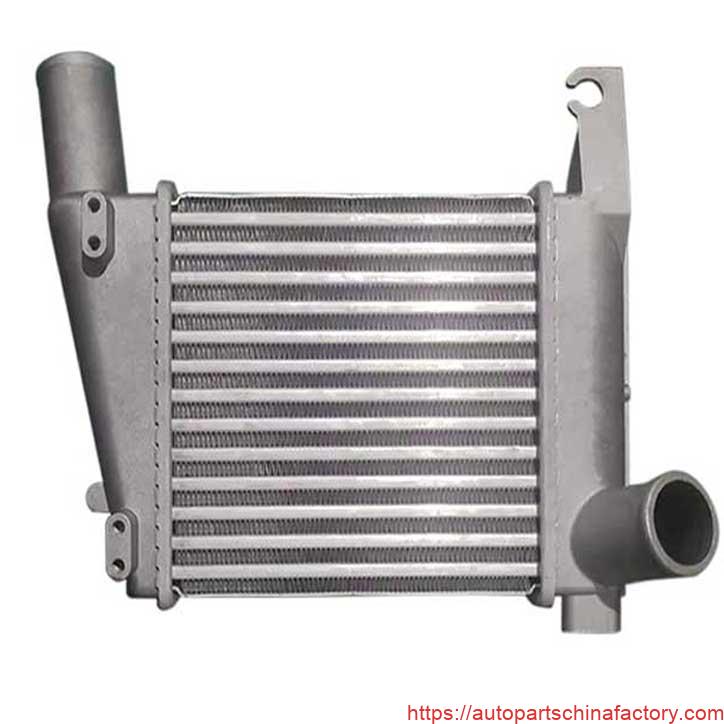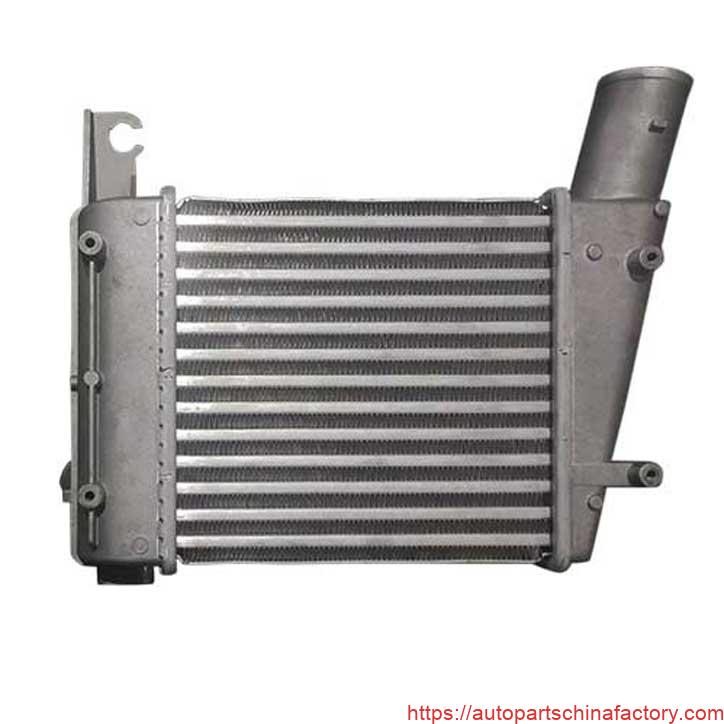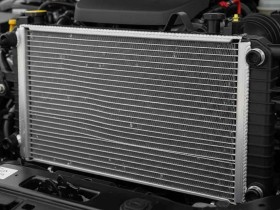- A+
If you own a Nissan Navara NP300 2.5TDI, you might be familiar with the part number 14461VMO0A. This crucial component is your vehicle's intercooler, playing a vital role in the performance and efficiency of your turbo diesel engine.

What is an Intercooler and Why is it Important?
In a turbocharged engine, the air that's forced into the cylinders by the turbocharger gets heated up significantly. Hot air is less dense, meaning it contains less oxygen. The intercooler acts as a radiator for this compressed air, cooling it down before it enters the engine.
The benefits of a properly functioning intercooler include:
- Increased Engine Power: Denser, cooler air means more oxygen for combustion, leading to a more powerful engine.
- ការធ្វើឱ្យប្រសើរឡើងនូវប្រសិទ្ធភាពប្រេងឥន្ធនៈ: More efficient combustion translates to better fuel economy.
- Reduced Engine Knock: Cooler air helps prevent premature detonation or "knocking," which can damage your engine.
- Lower Emissions: More complete combustion results in cleaner exhaust gases.
For Nissan Navara NP300 2.5TDI owners, ensuring your intercooler (part number 14461VMO0A) is in good condition is essential for maintaining optimal vehicle performance and longevity. Regular checks for leaks or damage are recommended.

Intercooler Upgrade Options
Nissan Navara NP300 intercoolers typically come in two main core designs:
- Tube-and-Fin: Lighter and offer excellent thermal conductivity, ideal for daily driving and moderate performance.
- Bar-and-Plate: More robust and durable, better suited for high-performance engines or demanding conditions like towing or off-roading.
Both are commonly constructed from aluminum, a lightweight, corrosion-resistant material with excellent heat transfer properties.
Installing a New Intercooler
While the specifics of installation will vary depending on the chosen intercooler and your vehicle's setup, the process typically involves:
- Removing the OEM intercooler and associated components.
- Preparing the new intercooler and its piping for installation, which might involve trimming hoses and attaching fittings.
- Mounting the intercooler, ensuring proper clearance from other components, particularly in the case of aftermarket bull bars.
- Connecting the intercooler to the intake system using hoses, clamps, and fittings.
- Refilling the engine's coolant system (if applicable) and bleeding the system of air pockets.
- Reinstalling the front bumper and grille.
Note: It's essential to ensure all fasteners and clamps are tight, and hoses are without kinks or chafing to prevent leaks and potential damage. If you are unsure about any part of the installation process, it's always best to consult with a professional.
Understanding the Science Behind the Cool:
As we mentioned, the turbocharger forces more air into the engine's cylinders, a process that inevitably increases the air's temperature. This heated, less dense air compromises the combustion process. The intercooler, essentially an air-to-air heat exchanger, steps in to cool this compressed air before it reaches the intake manifold.
Think of it like this: imagine trying to burn a tightly packed log versus a loosely arranged pile of twigs. The tightly packed log (hot, less dense air) will burn less efficiently. The intercooler helps to "loosen up" the air molecules by cooling them down, allowing for a more complete and powerful combustion.
Why a Healthy Intercooler Matters for Your Navara NP300:
Beyond the core benefits we previously discussed (increased power, improved fuel efficiency, reduced knock, and lower emissions), a well-maintained intercooler contributes to the overall longevity and reliability of your Nissan Navara's engine.
- Preventing Engine Damage: Excessive heat can put stress on engine components. By effectively cooling the intake air, the intercooler helps to mitigate this risk, protecting vital parts from premature wear and tear.
- Maintaining Consistent Performance: A faulty or inefficient intercooler can lead to noticeable drops in power, especially during hot weather or under heavy load. Ensuring your intercooler is functioning correctly guarantees consistent performance in various driving conditions.
- Optimizing Turbocharger Efficiency: The cooler, denser air entering the engine also helps the turbocharger operate more efficiently, contributing to its lifespan and performance.

Common Issues and Maintenance Tips for Your Intercooler (14461VMO0A):
Like any automotive component, the intercooler can experience issues over time. Here are some common problems to watch out for:
- Leaks: Physical damage from road debris or corrosion can cause leaks in the intercooler core or its connecting pipes. Leaks will result in a loss of boost pressure, leading to reduced power and efficiency. You might hear a hissing sound or notice oily residue around the intercooler.
- Blockages: Internal passages within the intercooler can become blocked with oil, dirt, or debris over time, restricting airflow and reducing its cooling efficiency.
- Damage to Fins: The delicate fins on the exterior of the intercooler help dissipate heat. Bent or damaged fins can hinder the cooling process.
- Loose Connections: Hoses and clamps connecting the intercooler to the turbocharger and intake manifold can become loose or cracked, leading to air leaks.
Here are some maintenance tips to keep your intercooler in good shape:
- Regular Visual Inspections: Check for any signs of physical damage, leaks, or loose connections. Pay attention to any unusual noises coming from the engine bay.
- Cleaning: Periodically clean the exterior fins of the intercooler from dirt and debris. Be careful not to bend the delicate fins. In some cases, professional cleaning of the internal passages might be necessary.
- Check Hoses and Clamps: Ensure all hoses are in good condition and clamps are securely fastened. Replace any cracked or damaged hoses immediately.
When is it Time for an Intercooler Replacement?
If you notice a significant drop in engine power, reduced fuel economy, or hear unusual noises that could indicate an intercooler issue, it's crucial to have your vehicle inspected by a qualified mechanic. If the intercooler is leaking, significantly damaged, or internally blocked, replacement is usually the best course of action.
For your Nissan Navara NP300 2.5TDI, the part number 14461VMO0A is the specific intercooler designed for your vehicle. Ensure you use the correct replacement part to guarantee proper fitment and performance.
Replacing Your Intercooler: A General Overview (Refer to your Vehicle's Service Manual):
While the exact procedure might vary slightly depending on the model year and specific configuration of your Navara NP300, here's a general overview of what's involved in replacing the intercooler:
- Preparation: Ensure the engine is cool. Disconnect the negative battery terminal.
- Removal of Surrounding Components: You may need to remove the front bumper, grille, or other components to access the intercooler.
- Disconnecting Hoses: Carefully loosen and remove the hoses connected to the intercooler. Be prepared for some oil residue.
- Removing the Old Intercooler: Unbolt the intercooler from its mounting points and carefully remove it from the vehicle.
- Installing the New Intercooler: Position the new intercooler (part number 14461VMO0A) and secure it to its mounting points.
- Reconnecting Hoses: Reattach the hoses to the new intercooler and tighten the clamps securely.
- Reassembly: Reinstall any components that were removed to access the intercooler (bumper, grille, etc.).
- Final Checks: Double-check all connections and ensure everything is properly secured. Reconnect the battery.
- Test Drive: Start the engine and take it for a test drive to ensure proper performance.
Note: Intercooler replacement can be a moderately complex task. If you are not comfortable working on your vehicle, it's always best to have the replacement performed by a qualified mechanic.
Investing in a healthy intercooler (part number 14461VMO0A) is an investment in the performance, សមត្ថផាប, and longevity of your Nissan Navara NP300 2.5TDI. By understanding its function, being aware of potential issues, and following proper maintenance practices, you can ensure your ride continues to deliver optimal performance for years to come.




